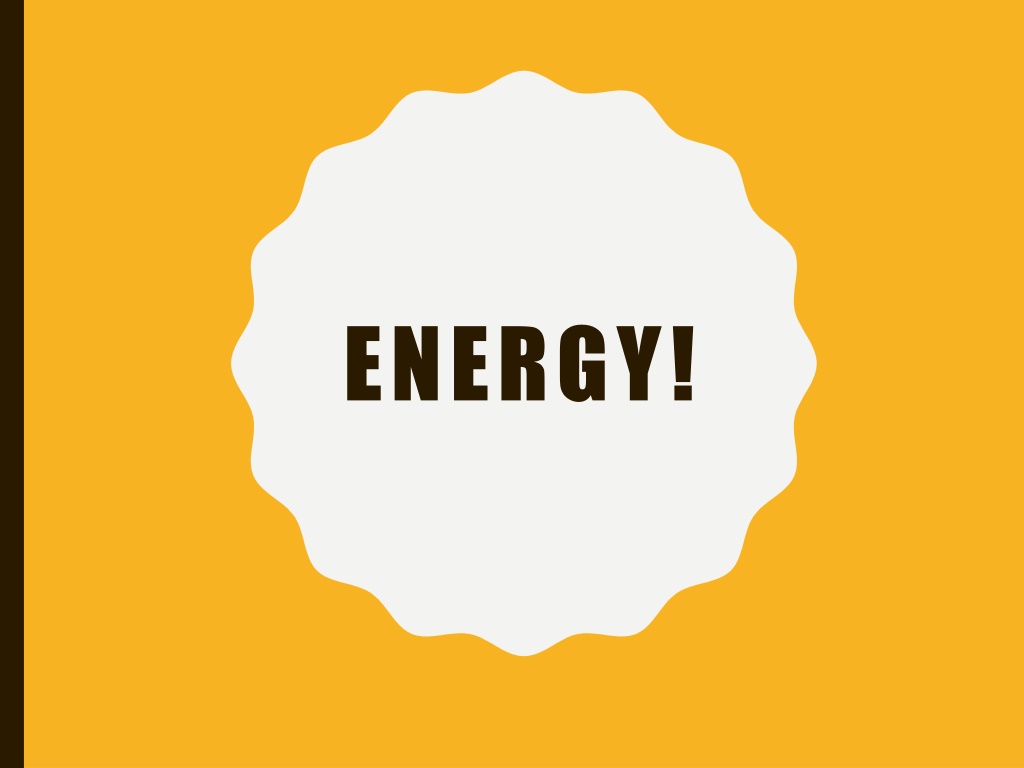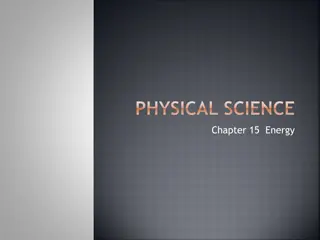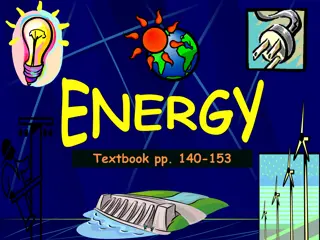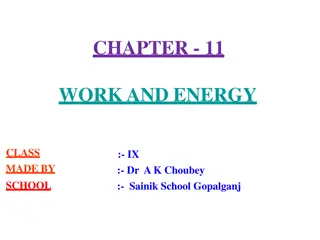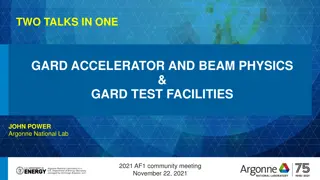Understanding Energy and its Forms in Physics
Energy is the capacity to do work and cause motion, measured in Joules (J). This presentation delves into potential energy (elastic and gravitational) and kinetic energy, explaining their formulas and practical applications through examples and practice questions.
Download Presentation

Please find below an Image/Link to download the presentation.
The content on the website is provided AS IS for your information and personal use only. It may not be sold, licensed, or shared on other websites without obtaining consent from the author. Download presentation by click this link. If you encounter any issues during the download, it is possible that the publisher has removed the file from their server.
E N D
Presentation Transcript
1) WHAT IS ENERGY? WHAT DOES IT DEAL WITH? 2) SOMETHING OR SOMEONE WITH ENERGY. WHAT DOES IT LOOK LIKE VS. SOMETHING THAT DOESN T?
ENERGY! Energy is the ability to do work, and ability to cause motion SI Unit = Joules (J) 1 Joule = 1 N * 1 m 1 Joule = (1 kg * m/s2) * 1m 1 Joule = 1 kg * m2/s2
POTENTIAL ENERGY Energy stored due to position or shape. It has the ability or potential to move. There are 2 types: 1) Elastic energy stored by things that stretch (or compress). Examples? - Rubber bands, sling shots, elastic, muscles, a spring, a ball bouncing, etc
POTENTIAL ENERGY 2) Gravitational Potential Energy- energy stored by objects that are lifted off the ground. GPE= mass * gravity * height A 65kg rock climber ascends a cliff. What is the climber s GPE at a point 35m above the base of the cliff? GPE = m * g * h GPE = 65kg * 9.8m/s2 * 35m GPE = 22295 joules
KINETIC ENERGY Kinetic energy of motion. Amount of energy depends on objects mass and velocity. Formula KE = m * v2 Units = Joules
KINETIC ENERGY Formula KE = m * v2 Units = Joules (remember 1J = 1N * 1m/s) Practice: What is the Kinetic Energy of a 44kg cheetah running at 31m/s? KE = m * v2 KE = (44 kg) * (31m/s)2 KE = (44 kg) * 916m2/s2 KE = 21,142 joules
PRACTICE QUESTIONS Potential Energy= m x g x h Kinetic energy= .5m x v2 1) A 70kg rock climber name Nolan Mandelkow ascends a cliff. What is the climber s GPE at a point 50m above the base of the cliff? 2) Nolan found a certain girl extremely attractive and started chasing after her. What is the Kinetic Energy of a 40kg Nolan Mandelkow running at 31m/s? 3) Nolan Mandelkow once climbed to the top of Barn s Bluff and was so tired he stopped talking .well not the stopped talking part. He was a 350m above the Mississippi and at that time weighed 100kg. How much energy does he possess?
THE 7 TYPES OF ENERGY! 1)Mechanical Energy 2)Chemical Energy 3)Electrical Energy 4)Nuclear Energy 5)Thermal Energy 6)Radiant Energy 7)Sound Energy
THE 7 TYPES OF ENERGY! 1) Mechanical Energy the energy stored in an object due to its motion or position. Mech Kinetic Energy: a moving car, a cheetah running Mech Potential Energy: stored in a spring, compressed ball, or a plane in the air Examples: A running kid, a flying plane, a potted plant sitting on a ledge
THE 7 TYPES OF ENERGY! 2) Chemical Energy Energy stored in the bonds that hold them together. Chem Potential Energy: stored in a battery or ethanol This energy changes into another form during chemical reactions. Examples: Food, batteries, humans, gasoline, trees, etc.
THE 7 TYPES OF ENERGY! 3) Electrical Energy Energy of electrons moving around a circuit. Elec Kinetic Energy: movement of electrons Elec Potential Energy: stored in a capacitor Examples: Batteries in cell phone, car batteries, lamp plugged into outlet. 4) Nuclear Energy Energy stored within the nucleus Examples: nuclear fission (nucleus splitting) at a nuclear power plant to provide electricity to a city, uncontrolled fission of a nuclear bomb, nuclear fusion (nucleus joining) in the sun
THE 7 TYPES OF ENERGY! 5) Thermal Energy type of energy that comes from heat and the movement or particles Examples: The sun, a grill, stove, 6) Light Energy energy associated with electromagnetic spectrum and light waves. Examples: radio waves, visible light, microwaves, X-rays 7) Sound Energy A form of mechanical energy that is produced when objects vibrate and travel through air, water, wood or metal.
LAW OF CONSERVATION OF ENERGY Energy can never be created or destroyed. Energy can only change from one form to another. Net Energy is the total amount of energy in a system. The total or net amount of energy must stay the same when energy changes forms.
LAW OF CONSERVATION OF ENERGY Before the drop If the 4kg soccer ball is held at a height of 5m, how much GPE does it have? GPE = M * G * H = 196 joules of GPE Because the ball is above the ground. If the 4kg soccer ball is held at a height of 5m, how much KE does it have? KE = mv2 = 0 joules of KE Because the ball not moving
LAW OF CONSERVATION OF ENERGY After the drop If the 4kg soccer ball is dropped, how much GPE does it have when it strikes the ground at 0m? GPE = M * G * H = 0 joules of GPE Because the height is 0m If the 4kg soccer ball is dropped, how much GPE does it have when it strikes the ground at 0m? KE = mv2 = 196 joules of KE Because the ball is moving as it s fastest speed.
LAW OF CONSERVATION OF ENERGY Recap: So for an object that is going to simply fall GPE at the Drop Point = KE at the Impact Point Because all of the GPE is converted to KE throughout the fall This only works for falling objects though . A roller coaster is not falling, per se
BUT A ROLLER COASTER IS NOT JUST A FALL As we start at the top of the 1sthill
ENERGY CHANGES ON THE ROLLER COASTER We saw on previous slide that the GPE the car has at the top of the 1st hill will turn into KE as the car travels down the hill. And that the KE the car has at the bottom of the 1st hill will turn into GPE as the car travels up the next hill. But is this a perfect transformation of energy from GPE to KE and back? Nope. Energy is lost as heat and sound.
ENERGY CONVERSIONS A Lightbulb Start with __Electricity_ End with ___Light__ Waste __Heat___ Can you determine the other 4 energy conversions? Remember: Law of Conservation of Energy A fan Start with __________ End with _________ Waste ________ A battery Start with __________ End with _________ Waste ________ A fire Start with __________ End with _________ Waste ________ A glowstick Start with __________ End with _________ Waste ________
ENERGY CONVERSION EXAMPLE: As a swing moves back and forth, the energy is converting from one form to another .. Why will the swing eventually stop? In what form will that energy be transferred into?
EXPLAIN THIS CONVERSION OF ENERGY Using the words gravitational potential energy, elastic potential energy, kinetic energy, and gravity You should also be able to discuss Newton s 3 Laws
EXPLAIN THIS CONVERSION OF ENERGY Using the words gravitational potential energy, elastic potential energy, kinetic energy, and gravity You should also be able to discuss Newton s 3 Laws
The Electromagnetic Spectrum
Things to Remember The higher the frequency, the more energy the wave has. EM waves do not require media in which to travel or move. EM waves are considered to be transverse waves because they are made of vibrating electric and magnetic fields at right angles to each other, and to the direction the waves are traveling. Inverse relationship between wave size and frequency: as wavelengths get smaller, frequencies get higher.
The Waves (in order) Radio waves: Have the longest wavelengths and the lowest frequencies; wavelengths range from 1000s of meters to .001 m Shortest are the microwaves Used for: RADAR, cooking food, satellite transmissions
Infrared waves (heat): Have a shorter wavelength, from .001 m to 700 nm, and therefore, a higher frequency. Used for finding people in the dark and in TV remote control devices Visible light is what we can SEE in the EM spectrum. Wavelengths range from 700 nm (red light) to 400 nm (violet light) with frequencies higher than infrared waves. Visible light waves are a very small part of the EM spectrum!
Ultraviolet Light: Wavelengths range from 400 nm to 10 nm; the frequency (and therefore the energy) is high enough with UV rays to penetrate living cells and cause them damage. Too much UV can lead to sunburn and skin cancer. However, we use UV to produce vitamin D in our bodies. UV rays are easily stopped by clothing. Used for sterilization because they kill bacteria. Although we cannot see UV light, bees, butterflies, and birds can (along with bats and small rodents).
X-Rays: Wavelengths from 10 nm to .001 nm. These rays have enough energy to penetrate deep into tissues and cause damage to cells but are stopped by dense materials, such as bone. Used for looking at solid structures, such as bones and bridges (for cracks), and for treatment of cancer.
WAVES AND WAVE PROPERTIES
If waves have a medium, it is called a mechanical wave. If waves can travel without a medium (such as space), it is called an electromagnetic wave (or EM wave).
Wave Types 1.Transverse waves: Waves in which the medium moves at right angles to the direction of the wave
2. Compressional (or longitudinal) waves: Waves in which the medium moves back and forth in the same direction as the wave
